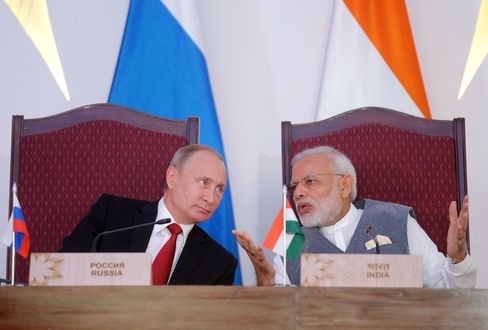By Siddharth Singh
The outcome of the 17th Annual India-Russia summit between President Vladimir Putin and Prime Minister Narendra Modi in Goa on October 15 again demonstrated that Russia continues to remain a trustworthy strategic partner for India, in changing global geo-political situations. Following delegation level talks, led by Putin and Modi, 16 major agreements were signed in sectors including defence, energy, trade and investment, space and smart cities. The highly productive outcomes of meeting clearly established the special and privileged nature of strategic partnership between both the countries. In a statement at a joint press briefing with Putin after the talks, PM Modi described India’s special partnership with Russia using a Russian proverb: “An old friend is better than two new friends.”
The 16 agreements signed after the talks include three prominent deals on bilateral defence cooperation: Inter-Governmental Agreements (IGAs) for five S-400 ‘Triumf’ air defence missile systems, four Admiral Grigorovich-class (Project 11356) guided missile stealth frigates and a share-holders agreement for a joint venture (JV) to manufacture 200 ‘Kamov’-226 helicopters in India.
These defence deals are extremely significant especially in context of India’s recently materialized Logistics Exchange Memorandum of Agreement (LEMOA) with the US. The LEMOA provides conditional US access to military bases in India, giving a perception that it was drifting away from Russia. It is expected that by 2020, Russia will start delivery of S-400s to India. It is considered one of the most advanced long range missile systems in the world and can tackle all incoming airborne targets at ranges of up to 400 km.
The Hindustan Aeronautics Limited (HAL) and Russia’s Rostec State Corporation will set up a joint venture to manufacture 200 Kamov-226 helicopters, at the location of HAL’s choice. Of the four improved Krivak or Talwar class stealth frigates, two will be built in Russia and the other two in India with Russian assistance. These defence deals are estimated to cost India a total of around $10 billion. While the cost of S-400s will be about $5 billion, the deals relating to the Kamov-226 helicopters and the stealth frigates will be worth $1 billion and $3 billion, respectively.
The agreements on manufacturing of Kamov- 226 helicopters, constructions of frigates, and acquisition and building of other defence platforms are in synergy with India’s technology and security priority. These deals will also be helpful for India to achieve the objectives of ‘Make in India’ programme.
During the talks, both countries also agreed to organize an annual military industrial conference beginning later in 2016. It is expected to allow stake-holders on both sides to institute and push collaboration. The joint statement which was issued after the talks also stated that the India-Russia military industrial conference will address military-related issues, including spares, repair, and maintenance of Russian supplied equipment and co-production.
India and Russia have also signed an important agreement for the joint study of a gas pipeline to India from Russia. Apart from this, Russia has also agreed to invest $500 million into the Indian infrastructure, along with an equal investment by the newly formed National Infrastructure Investment Fund (NIIF), to form a $1 billion “Russian-Indian Investment Fund.”An MoU was signed to set up the bilateral investment fund by NIIF of India with Russian Direct Investment Fund (RDIF), to facilitate high-technology investment in both the countries.
Via video conferencing, Putin and Modi dedicated the second unit and launched the work for the third and fourth units of the Kudankulam Nuclear Power Project. Nuclear energy will make a very significant contribution to the energy security of India. It will give an additional impetus to the growth of the Indian economy.
India and Russia also signed an agreement on cooperation on International Information Security, to counter terrorism and drug-trafficking. Russia’s clear stand on the need to combat terrorism mirrors India’s concern over the issue. PM Modi, in his press statement, deeply appreciated Russia understanding and support for India’s actions to fight cross-border terrorism that threatens the entire region. Both countries have time and again reaffirmed the need for zero tolerance in dealing with terrorists and their supporters.
On the energy deals, which also included a deal by Gazprom to increase engagement with India, Russia is slowly opening its energy sector for India because Russia considers India as one of the most natural partners in the field of energy.
So fresh impetus has been provided to the strategic partnership between India and Russia during President Putin’s recent visit to India. His visit has reinforced the interests of both countries in maintaining their traditionally close and friendly relationship. In coming years, India and Russia have to exploit their comparative advantages in a globalising world if they wish to expand bilateral trade and deepen economic co-operation. This is imperative to add greater weight to their strategic partnership in the 21st century.
(Siddharth Singh is a research scholar at School of International Studies, JNU, New Delhi)
(The views expressed are the author's own and do not necessarily reflect the position of the organisation)

